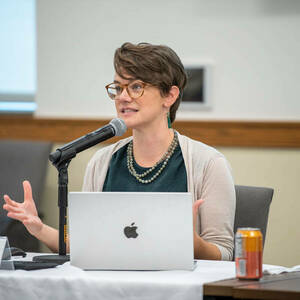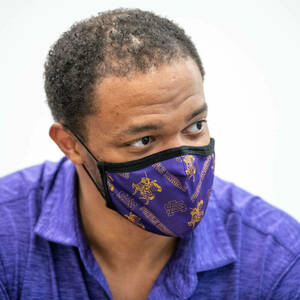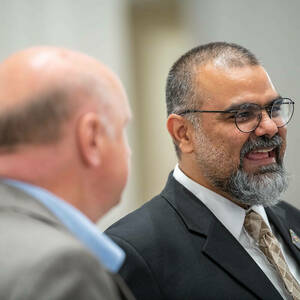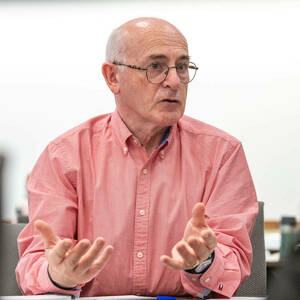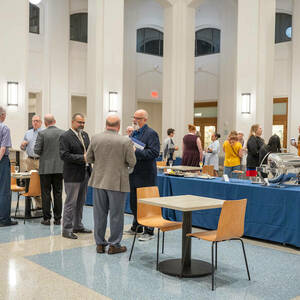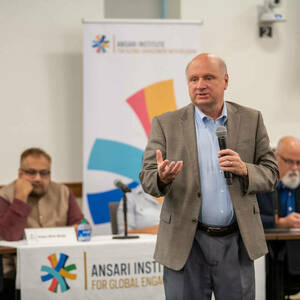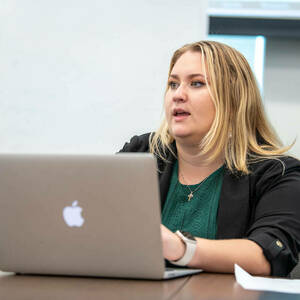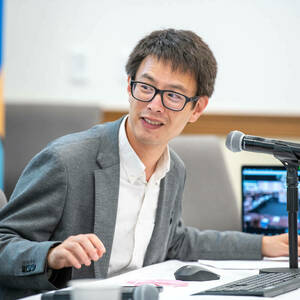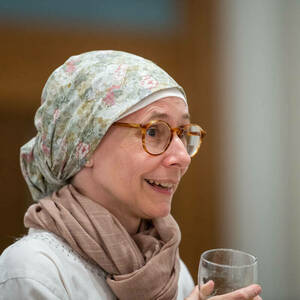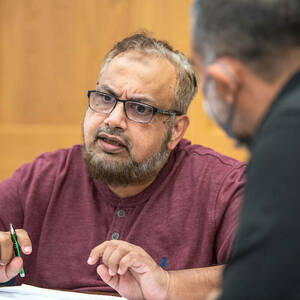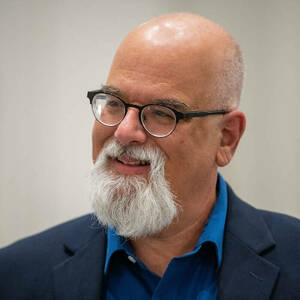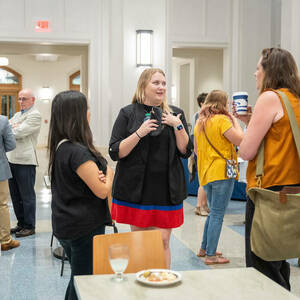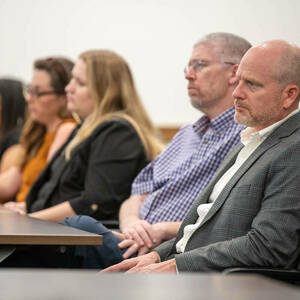Summary
In order to process how news media has covered religion and memory since 2001, the year of the Sept. 11 terror attacks and Catholic Archdiocese of Boston sex abuse scandal, our trialogue featured individual participants’ presentations, large-group discussions, and small-group response sessions. We represented three separate but interlinked vocations—journalism, academia, and religion. We wanted to discuss traumatic stories involving “bad religion” as well as counterstories that nuance or complicate narratives that draw links religion and violence. Academics contributed historical, theological, and ethical perspectives on their researching and teaching religion; media professionals discussed their craft and constraints in covering the faith beat; and religious leaders expanded on their responsibilities to respond to global news events from the pulpit, and to hear and tell the stories of their communities.
We organized our three days together with three intertwined themes:
- Day One’s “Preserving Memories” focused on how religious and media professionals work to create a record of religious diversity, conflict, and healing;
- Day Two’s “Providing Contexts” critically investigated how broader fields of power (church and partisan politics, social media, gentrification) work to amplify some stories and silence others; and,
- Day Three’s “Preparing Lessons” explored professional dilemmas in bearing witness to powerful stories, and queried religion’s reparative powers and limits.
Day One
Mahan Mirza set the stage for the workshop: Academic scholars of religion often deplore what they perceive as lack of nuance or sensationalism around religion in headline news; journalists often find academic accounts of religion too abstract or overcomplicated; and faith leaders sometimes find news stories and academic reports about their communities misinformed and condescending. What’s more, each of these three professions is internally riven by partisan political divides. These impasses, he proposed, could be overcome through small-scale trialogues—bringing representatives from our three professions together to identify and build on our commonalities in order to understand more deeply our vocational differences to mutual advantage. The Ansari Institute’s October 2019 conference, Religion Beyond Memes: Enhancing Public Discourse about Faith and Practice, he explained, emphasized the potential of building workshops to pursue shared, working understanding of how our respective professions engage with religion, its varied representations, and the public.
Encounter and conversation can help journalists, educators, and faith leaders pursue shared, working understandings of how our respective professions engage with religion and the public.
While initiatives like the Faith Angle Forum bring together academics and journalists to discuss religion’s role in public life, and programs like Sacred Writes train scholars to navigate the media landscape in producing public-facing scholarship, we wanted to build a set of workshops to bring faith leaders directly into the conversation. “Faith in the Story” refers both to our shared dedication to keeping authentic and complex stories about religion in the news, and our commitment to the stories we are compelled to tell from our respective vocations. Participants had been asked to distribute news stories they either wrote or wanted to comment on before the workshop; each participant contributed their own analysis, and through sustained conversation the group was able to read deeper into the news.
Bob Smietana kicked our proceedings off in “Only a Fool Fights in a Burning House”—a Klingon saying from Star Trek on the inadvisability of stoking further trouble in a crisis—by reflecting on his reporting about Islamophobic tensions in central Tennessee from 2008-2010 and the Southern Baptist Convention’s reckoning with sexual abuse allegations against pastoral abusers and enablers in 2021-2022. The Christians he built connections with could be power-brokering operators or fear-mongering bad actors one moment, but paragons of Christian generosity in the next, as helpful, curious actors, reflecting the “scope of religion in America.” Journalists need to attend to religious leaders’ capacity for troublemaking (the ultraconservative Christian “anti-Jihad” industry, for instance) as well as providing pathways toward healing and reform (Pastor Todd Benkert’s motion for the SBC’s Executive Committee to commit to an independent sex abuse report in June 2021).
Alejandra Molina’s “From the Outside In: Amplifying Excluded and Misrepresented Religious Voices,” described building sources in reporting about American Muslim women and Latino Catholics’ views on abortion. Social media enabled Molina to find individuals with unique voices and compelling stories. It also allowed critics to find fault with these less dominant representations of their faiths, and led to kinder readers expressing gratitude for being exposed to new views and for seeing their own viewpoints represented.
Our first response session focused on “Our Professions.” Through a set of questions that asked us to identify commonalities, the three professions first broke into three groups according to their professions to discuss the joys and challenges of our respective callings and the callings of the other two groups. We then broke into groups with one academic, journalist, and faith leader each to compare notes and build mutual understanding. Our presentation sessions continued with Maytha Alhassen in “Haqq and Hollywood,” who shared how Hollywood representations of Muslims have gone from “Aladdin” and “terrorist” tropes to something more sophisticated and interesting, especially since 2016. With more and more diverse kinds of Muslims in entertainment, we have seen modest success in faithful, complex representations of Muslim individuals and communities.
Anila Ali’s “How 9/11 Propelled Muslim Women into Peacemaking” described building political solidarity with Muslim-American women with familial origins from around the world, fighting male dominance within Islam on the one hand and a mainstream American narrative equating Islam with violent extremism on the other. Then, Bilal Malik in “What Is Sharia Law?” spoke on fundamental teachings of Islam, correcting common misunderstandings about “jihad” and “sharia law.” Jihad consists of the personal struggle to live the faith and can invoke the self-defense of community, while sharia law deals with rights and responsibilities toward God and His creation. Finally, Mahan Mirza and Alexander Hsu led a discussion session about Graeme Wood’s 2015 Atlantic piece, “What ISIS Really Wants” and Islamic studies scholar Caner K. Dagli’s critical response to it. They asked, why should Wood’s account of the Islamic State of Iraq and al-Sham as “very Islamic” carry so much authority? For reporters, scholars, and faith leaders alike, living in a post-9/11 world requires continual teaching and correction of the record about global Islam.
Day Two
In “Psychological and Emotional Implications of Religiously Inspired News: Moral Outrage and Compassion Fatigue,” Syed Ali Hussain described his communications research into how news about religion travels over social media networks in Myanmar, Pakistan, and the United States. He found that moral framings of stories that flatter an in-group against a threatening out-group can inspire social media users to further circulate a story and pursue explicitly political action. Megan Goodwin’s “We Always Forget: Abuse, Complicity, and American Religion,” situated the Spotlight story against a broad tapestry of powerful social forces: white Christian supremacy, a “Catholicization of public morality” around abortion and gender politics, and institutionally induced amnesia about abuse.
Next, Alexander Hsu and Peter Cajka led the day’s discussion session, “Accountability for All: How Scholars, Journalists, and Faith Leaders Keep Account of One Another in an Abuse Crisis.” Cajka explained how historians and other scholars of Catholicism are beginning to recognize Catholic sex abuse crises as an integral part of modern Catholic historiography, with the assistance of sympathetic journalists and faith leaders. The story is so big it requires multiple, differently positioned tellers to continue to do it justice; and it is one that is still unraveling, sometimes in unpredictable directions.
It was important for us to identify how powerful contexts shape how our stories about heroes and villains are fashioned and received.
Susan Reynolds, in “When Memories are Places: Lessons from Boston’s Post-Spotlight Parish Shutdown,” described the story of St. Mary’s of the Angels parish in Boston, whose members mobilized a successful campaign to keep their Latino parish open by “proving that [they] have a future” to leaders who had been considering selling the church to developers. Nichole Flores, in “Never Forget the Northside: Erasure, Memory, and Religion in Chicano Denver,” spoke about Chicano communities battling gentrification in the form of parish shutdowns and mural destructions—“a systematic erasure of theology.” Reynolds and Flores reminded us that memory—whose stories are worth retelling—is inherently theological and political, in and of places and the communities that struggle to thrive in them.
We closed out the day with our second response session on “How We Tell Stories,” where we spoke within professions about what we thought good teaching, reporting, and ministry look like; and we spoke across professions about how stories are inspired, crafted, authored, and adapted for different purposes. In answering questions about stories’ “hooks,” what inspires stories “besides a deadline,” and “stories that are important for you to tell but that audiences find difficult to hear,” individual participants could begin to reimagine their respective challenges as shared ones. It was important for us to identify how powerful contexts—the places we inhabit, the folks we are responsible for, and the identities we share with others (religious and racial among others)—shape how our stories about heroes and villains are fashioned and received.
Day Three
Jessica Mesman’s “Off the Rails: Finding My Way as a (Catholic) Writer and Editor After Revelations of Abuse” described how sexual abuse in religious settings can destroy the professional and spiritual lives of victims. She recounted building a supportive community of religion writers, weathering a member’s betrayal of the group’s confidence and the following press coverage, and rebuilding her career and her faith in the wake. She prescribed serious professional attention to how our professions report, publish, and publicize abuse stories because the impact on victims’ lives is often egregiously underthought. The professional mediator Brendan McAllister’s “Reflecting on Peace and Reconciliation” shared tools for and stories about building confidence between parties in postconflict arenas: ideally everybody will recognize themselves and each other in the stories that get told in the aftermath. McAllister encouraged us to recognize both peace and conflict as “dynamic phenomena” having their own “emotional lives,” to grow sensitivity in situations where the players and personalities continue to evolve.
BeLynn Hollers, in “Is Abortion a Religion Story? In Texas, I Thought I Knew the Answer,” spoke about covering the abortion politics beat in the year before the Dobbs decision: though reporting involved joyful discoveries and maintaining friendly relationships with activists on both sides. She recalled how it remained a professional challenge to tell the stories of abortion patients ethically. Kristin Du Mez described her “Lessons Learned” from having written Jesus and John Wayne, a bestselling history about American evangelicalism, its views about masculinity, and its conservative politics: she found herself part of the story she was telling, as Christian readers debated the book’s arguments and its relevance to the future of evangelical politics, and she found her own personal faith and political views under a microscope.
Imperfect as the story may be, damaged or compromised as we might feel, the fact that truth-telling work is attempted remains a source of real hope.
Michael Cramer’s “Soaring with our Strengths” shared with us how his church honored its war heroes over the last century, and he recalled 9/11 as a moment when the community came together as one and members helped to support each another. He reminded us that although terrible injustice and pain may be suffered, recovery and flourishing are worth fighting for, as “all things are possible with God.” The final response session featured Mahan Mirza and Alexander Hsu explaining in greater detail the origins of “Faith and the Story” and soliciting feedback for the future of these trialogues.
Nichole Flores, Bilal Malik, Brendan McAllister, Bob Smietana, led our concluding evening public panel, summarizing what they had learned as individuals and what we learned as a group. They spoke about common commitments to raise up stories about the marginalized and abused of all religious backgrounds; common challenges in how to report on or publish academic research on trauma that could compound victims’ difficulties; and common temptations to tell well-worn stories that audiences already expect. Imperfect as the story may be, damaged or compromised as we might feel, that the truth-telling work is attempted at all remains “a source of real hope,” Scott Appleby remarked.

